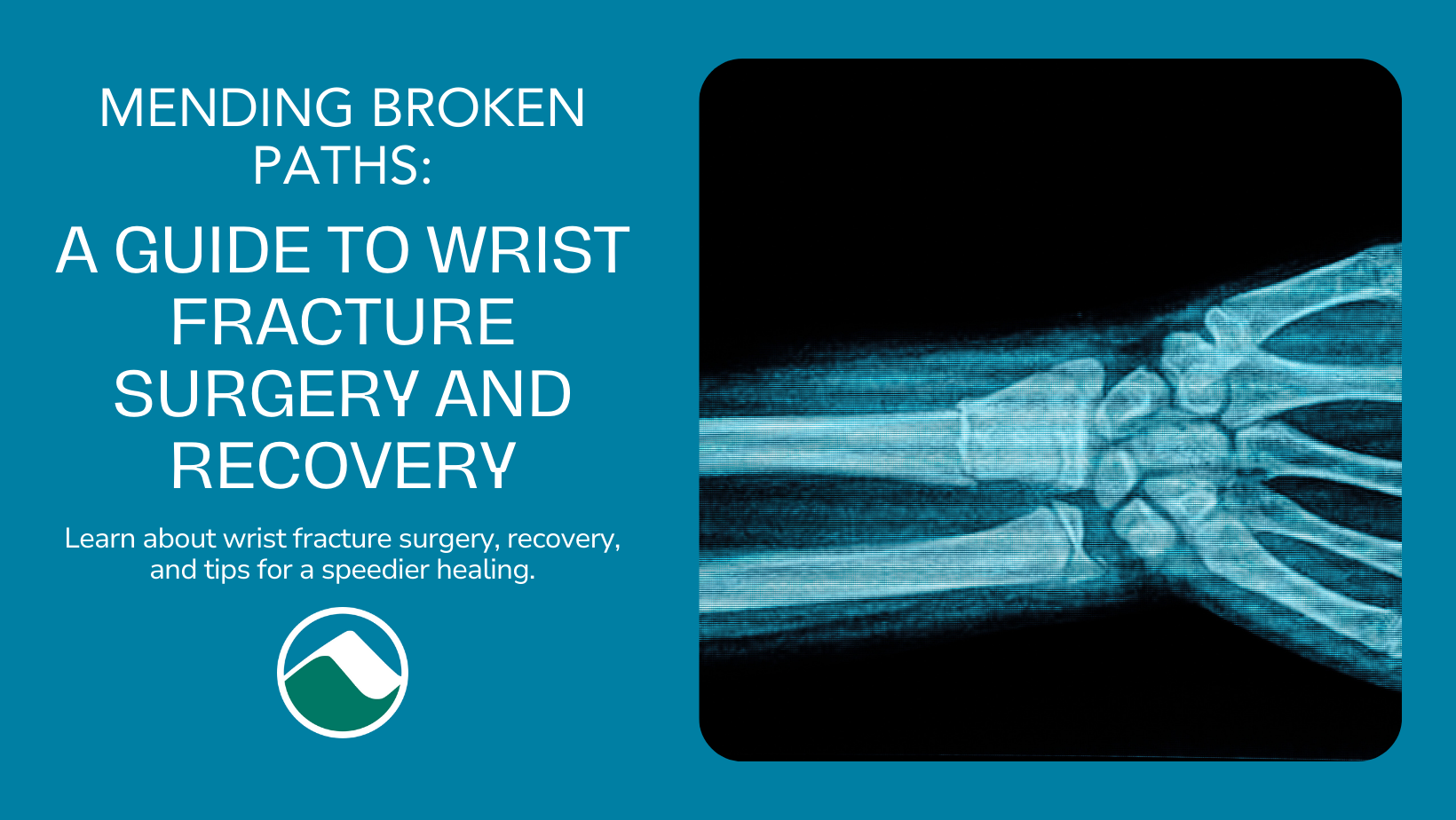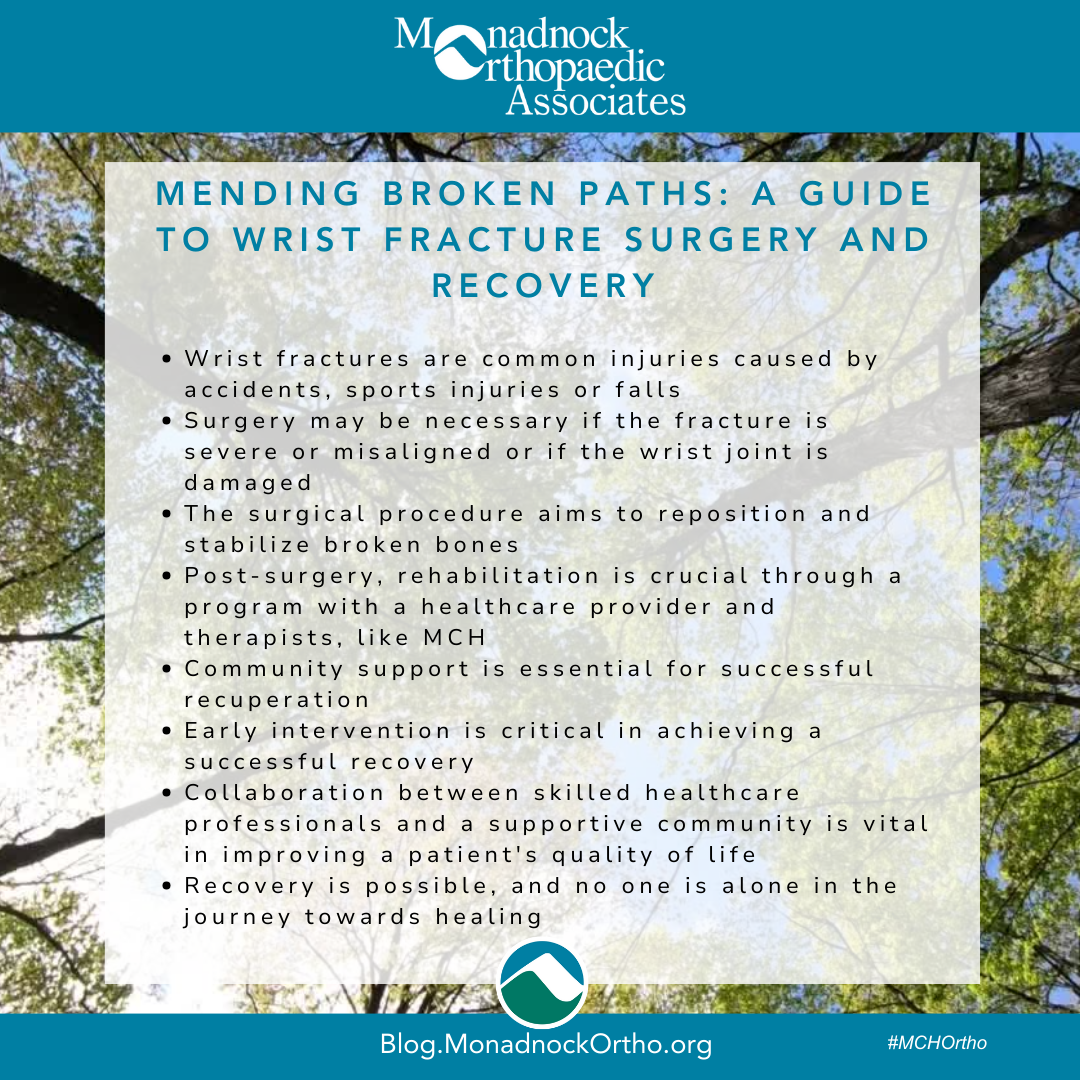A Guide to Wrist Fracture Surgery and Recovery


Let’s delve into the world of wrist fracture surgery, a topic that many of us might not think about until we or a loved one faces this challenge. Wrist fractures are more common than you might imagine, often occurring due to accidents, sports injuries, or even simple falls.
Understanding the Wrist Fracture:
Wrist fractures can be painful and debilitating, but the good news is that modern medical advancements have made the surgical procedure for treating them safer and more effective than ever before. Whether you’ve personally experienced a wrist fracture or are just interested in learning more, let’s break it down step by step.
When Surgery is Necessary:
First and foremost, not every wrist fracture requires surgery. Many can be effectively treated with casting or splinting, especially when the bones are well-aligned. However, if the fracture is severe, if the bones are misaligned, or if the wrist joint is damaged, surgery may be the best course of action. Orthopedic surgeons carefully assess the individual case to determine the most appropriate treatment.
The Surgical Process:
Wrist fracture surgery is typically performed under anesthesia, ensuring the patient’s comfort throughout the procedure. The surgeon will make an incision to access the fracture site, where they will then reposition and stabilize the broken bones using specialized equipment such as screws, plates, or pins. This process aims to restore proper wrist alignment and stability.
Recovery and Rehabilitation:
Post-surgery, the road to recovery is crucial. Patients are often guided through a rehabilitation program like the ones offered at MCH, that may include physical therapy to regain wrist strength and mobility. This collaborative approach between patients, healthcare providers, and therapists is fundamental to achieving the best results during the healing journey.
Community Support:
Having a supportive network is essential during recovery. Friends, family, and local healthcare facilities like Monadnock Community Hospital play a significant role in ensuring a patient’s successful recuperation.
The Importance of Early Intervention:
 Recognizing the signs of a wrist fracture and seeking medical attention promptly is vital. The sooner a fracture is diagnosed and treated, the better the chances of a successful recovery.
Recognizing the signs of a wrist fracture and seeking medical attention promptly is vital. The sooner a fracture is diagnosed and treated, the better the chances of a successful recovery.
Wrist fracture surgery is a process that, while potentially daunting, can significantly improve a patient’s quality of life. The collaboration between skilled healthcare professionals and a supportive community, such as the one found in Peterborough and at Monadnock Community Hospital, can make all the difference.
Remember, should you or a loved one ever face a wrist fracture, trust in the medical expertise available and the caring community that surrounds you. Recovery is possible, and you’re never alone in the journey towards healing.
Stay well, and let’s continue to learn, support, and grow together as a community.
Dr. Vache Hambardzumyan, MD, PhD, FEBS

Expert Advice from Dr. Vache Hambardzumyan
“Wrist fracture surgery is an important step toward regaining full functionality and relieving pain. A personalized recovery plan, including proper rehabilitation, is key to achieving the best outcomes.”
About Dr. Vache Hambardzumyan
Dr. Vache Hambardzumyan, MD, PhD, FEBS, is a board-certified orthopedic surgeon with extensive expertise in treating fractures and other musculoskeletal injuries. With a focus on personalized care and cutting-edge surgical techniques, Dr. Hambardzumyan helps patients recover quickly and regain mobility with confidence.
Quick Tip: “Start gentle wrist exercises as soon as your doctor clears you. Gradual movement is essential for preventing stiffness and promoting healing.”
Why Choose Monadnock Orthopaedic Associates?
Our board-certified fracture specialists combine decades of experience with training from prestigious institutions like the Mayo Clinic. We offer comprehensive orthopedic care using advanced techniques and technology, all while providing personalized attention. At Monadnock Orthopaedic Associates, we’re committed to getting you back to pain-free living as quickly as possible with expert, compassionate care tailored to your unique needs. Choose us for expert care that’s close to home, where your well-being is our highest priority.
 Monadnock Orthopedic Associates
Monadnock Orthopedic Associates
Monadnock Community Hospital
Bond Wellness Center Suite 200
458 Old Street Road
Peterborough, NH 03458
Phone: 603-924-2144
Fax: 603-924-3993
Array
(
[section_title] =>
[section_text] =>
[posts_selection] => auto_taxonomy_terms
[section_posts] => Array
(
[0] => WP_Post Object
(
[ID] => 40161
[post_author] => 9192204
[post_date] => 2025-05-08 11:19:40
[post_date_gmt] => 2025-05-08 15:19:40
[post_content] =>
[post_title] => In the News: Osteoporosis: Understanding Risk Factors and Prevention Strategies
[post_excerpt] =>
[post_status] => publish
[comment_status] => closed
[ping_status] => closed
[post_password] =>
[post_name] => news-osteoporosis-prevention-250508
[to_ping] =>
[pinged] =>
[post_modified] => 2025-05-08 11:35:24
[post_modified_gmt] => 2025-05-08 15:35:24
[post_content_filtered] =>
[post_parent] => 0
[guid] => https://monadnockcommunityhospital.com/?p=40161
[menu_order] => 0
[post_type] => post
[post_mime_type] =>
[comment_count] => 0
[filter] => raw
)
[1] => WP_Post Object
(
[ID] => 40154
[post_author] => 9192204
[post_date] => 2025-05-06 16:55:56
[post_date_gmt] => 2025-05-06 20:55:56
[post_content] =>
[post_title] => Heartfelt Stories - Partners in Progress, Healing with Purpose
[post_excerpt] =>
[post_status] => publish
[comment_status] => closed
[ping_status] => closed
[post_password] =>
[post_name] => patient-stories-cady-2025
[to_ping] =>
[pinged] =>
[post_modified] => 2025-05-19 14:02:12
[post_modified_gmt] => 2025-05-19 18:02:12
[post_content_filtered] =>
[post_parent] => 0
[guid] => https://monadnockcommunityhospital.com/?p=40154
[menu_order] => 0
[post_type] => post
[post_mime_type] =>
[comment_count] => 0
[filter] => raw
)
[2] => WP_Post Object
(
[ID] => 39804
[post_author] => 9192204
[post_date] => 2025-02-23 14:16:26
[post_date_gmt] => 2025-02-23 19:16:26
[post_content] =>
[post_title] => Celebrating Excellence: Dr. Vache Hambardzumyan’s 100th Spine Surgery Milestone at MCH
[post_excerpt] =>
[post_status] => publish
[comment_status] => closed
[ping_status] => closed
[post_password] =>
[post_name] => vache-100th-spine-surgery-milestone
[to_ping] =>
[pinged] =>
[post_modified] => 2025-02-25 16:57:35
[post_modified_gmt] => 2025-02-25 21:57:35
[post_content_filtered] =>
[post_parent] => 0
[guid] => https://monadnockcommunityhospital.com/?p=39804
[menu_order] => 0
[post_type] => post
[post_mime_type] =>
[comment_count] => 0
[filter] => raw
)
[3] => WP_Post Object
(
[ID] => 39726
[post_author] => 9192204
[post_date] => 2025-01-27 07:18:52
[post_date_gmt] => 2025-01-27 12:18:52
[post_content] =>
[post_title] => Video: Explore the Future of Spine Care: Minimally Invasive Spine Surgery Seminar
[post_excerpt] =>
[post_status] => publish
[comment_status] => closed
[ping_status] => closed
[post_password] =>
[post_name] => innovations-in-minimally-invasive-spine-surgery-video-2025
[to_ping] =>
[pinged] =>
[post_modified] => 2025-04-07 09:33:08
[post_modified_gmt] => 2025-04-07 13:33:08
[post_content_filtered] =>
[post_parent] => 0
[guid] => https://monadnockcommunityhospital.com/dr-vache-hambardzumyan-orthopedic-surgeon-copy/
[menu_order] => 0
[post_type] => post
[post_mime_type] =>
[comment_count] => 0
[filter] => raw
)
[4] => WP_Post Object
(
[ID] => 39463
[post_author] => 9192204
[post_date] => 2025-01-13 16:23:34
[post_date_gmt] => 2025-01-13 21:23:34
[post_content] =>
[post_title] => Provider Spotlight: From Armenia to New Hampshire: Dr Vache's Journey of Healing and Hope
[post_excerpt] =>
[post_status] => publish
[comment_status] => closed
[ping_status] => closed
[post_password] =>
[post_name] => dr-vache-hambardzumyan-orthopedic-surgeon
[to_ping] =>
[pinged] =>
[post_modified] => 2025-04-07 10:28:22
[post_modified_gmt] => 2025-04-07 14:28:22
[post_content_filtered] =>
[post_parent] => 0
[guid] => https://monadnockcommunityhospital.com/dr-terrence-mcnamara-pain-management-specialist-copy/
[menu_order] => 0
[post_type] => post
[post_mime_type] =>
[comment_count] => 0
[filter] => raw
)
[5] => WP_Post Object
(
[ID] => 39693
[post_author] => 9192204
[post_date] => 2025-01-05 09:59:13
[post_date_gmt] => 2025-01-05 14:59:13
[post_content] =>
[post_title] => Reflecting on a Year of Care: Stories of Compassion and Community
[post_excerpt] =>
[post_status] => publish
[comment_status] => closed
[ping_status] => closed
[post_password] =>
[post_name] => celebrating-2024-compassionate-care-stories
[to_ping] =>
[pinged] =>
[post_modified] => 2025-05-19 13:58:07
[post_modified_gmt] => 2025-05-19 17:58:07
[post_content_filtered] =>
[post_parent] => 0
[guid] => https://monadnockcommunityhospital.com/patient-stories-copy/
[menu_order] => 0
[post_type] => post
[post_mime_type] =>
[comment_count] => 0
[filter] => raw
)
[6] => WP_Post Object
(
[ID] => 39124
[post_author] => 9192204
[post_date] => 2024-11-25 07:22:17
[post_date_gmt] => 2024-11-25 12:22:17
[post_content] =>
[post_title] => Osteoporosis: Understanding Risk Factors and Prevention Strategies
[post_excerpt] =>
[post_status] => publish
[comment_status] => closed
[ping_status] => closed
[post_password] =>
[post_name] => osteoporosis-risk-factors-prevention
[to_ping] =>
[pinged] =>
[post_modified] => 2025-05-19 14:10:21
[post_modified_gmt] => 2025-05-19 18:10:21
[post_content_filtered] =>
[post_parent] => 0
[guid] => https://monadnockcommunityhospital.com/benefits-limb-lengthening-surgery-copy/
[menu_order] => 0
[post_type] => post
[post_mime_type] =>
[comment_count] => 0
[filter] => raw
)
[7] => WP_Post Object
(
[ID] => 39430
[post_author] => 9192204
[post_date] => 2024-11-12 07:48:59
[post_date_gmt] => 2024-11-12 12:48:59
[post_content] =>
[post_title] => Join Us for Our Spring Health and Wellness Seminar Series: Knowledge for Better Health
[post_excerpt] =>
[post_status] => publish
[comment_status] => closed
[ping_status] => closed
[post_password] =>
[post_name] => seminars-spring-2025
[to_ping] =>
[pinged] =>
[post_modified] => 2025-05-19 14:01:07
[post_modified_gmt] => 2025-05-19 18:01:07
[post_content_filtered] =>
[post_parent] => 0
[guid] => https://monadnockcommunityhospital.com/nutrition-nurtures-seminar-2024-copy/
[menu_order] => 0
[post_type] => post
[post_mime_type] =>
[comment_count] => 0
[filter] => raw
)
[8] => WP_Post Object
(
[ID] => 39429
[post_author] => 9192204
[post_date] => 2024-11-10 14:18:29
[post_date_gmt] => 2024-11-10 19:18:29
[post_content] =>
[post_title] => Expanding Specialized Care: New Service Lines at Monadnock Community Hospital
[post_excerpt] =>
[post_status] => publish
[comment_status] => closed
[ping_status] => closed
[post_password] =>
[post_name] => new-services-2024
[to_ping] =>
[pinged] =>
[post_modified] => 2025-05-19 10:21:35
[post_modified_gmt] => 2025-05-19 14:21:35
[post_content_filtered] =>
[post_parent] => 0
[guid] => https://monadnockcommunityhospital.com/comprehensive-healthcare-services-copy/
[menu_order] => 0
[post_type] => post
[post_mime_type] =>
[comment_count] => 0
[filter] => raw
)
[9] => WP_Post Object
(
[ID] => 38029
[post_author] => 9192204
[post_date] => 2024-09-30 07:20:13
[post_date_gmt] => 2024-09-30 11:20:13
[post_content] =>
[post_title] => Limb Lengthening Surgery | Solutions for Limb Length Discrepancies
[post_excerpt] =>
[post_status] => publish
[comment_status] => closed
[ping_status] => closed
[post_password] =>
[post_name] => benefits-limb-lengthening-surgery
[to_ping] =>
[pinged] =>
[post_modified] => 2025-04-15 09:55:52
[post_modified_gmt] => 2025-04-15 13:55:52
[post_content_filtered] =>
[post_parent] => 0
[guid] => https://monadnockcommunityhospital.com/?p=38029
[menu_order] => 0
[post_type] => post
[post_mime_type] =>
[comment_count] => 0
[filter] => raw
)
[10] => WP_Post Object
(
[ID] => 38030
[post_author] => 9192204
[post_date] => 2024-09-02 07:20:15
[post_date_gmt] => 2024-09-02 11:20:15
[post_content] =>
[post_title] => Endoscopic Spine Surgery | Discectomy & Laminectomy Surgery
[post_excerpt] =>
[post_status] => publish
[comment_status] => closed
[ping_status] => closed
[post_password] =>
[post_name] => benefits-of-minimally-invasive-endoscopic-spine-surgery
[to_ping] =>
[pinged] =>
[post_modified] => 2025-04-10 16:58:58
[post_modified_gmt] => 2025-04-10 20:58:58
[post_content_filtered] =>
[post_parent] => 0
[guid] => https://monadnockcommunityhospital.com/?p=38030
[menu_order] => 0
[post_type] => post
[post_mime_type] =>
[comment_count] => 0
[filter] => raw
)
[11] => WP_Post Object
(
[ID] => 38028
[post_author] => 9192204
[post_date] => 2024-08-05 08:00:09
[post_date_gmt] => 2024-08-05 12:00:09
[post_content] =>
[post_title] => Minimally Invasive Discectomy Benefits | Herniated Disc Treatment
[post_excerpt] =>
[post_status] => publish
[comment_status] => closed
[ping_status] => closed
[post_password] =>
[post_name] => benefits-minimally-invasive-discectomy
[to_ping] =>
[pinged] =>
[post_modified] => 2025-04-10 17:00:10
[post_modified_gmt] => 2025-04-10 21:00:10
[post_content_filtered] =>
[post_parent] => 0
[guid] => https://monadnockcommunityhospital.com/?p=38028
[menu_order] => 0
[post_type] => post
[post_mime_type] =>
[comment_count] => 0
[filter] => raw
)
)
[posts_limit] => 12
[post_type] => post
[taxonomy] => tag
[terms] => hambardzumyan, hand
[section_id] => post-grid-7
)
